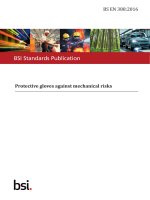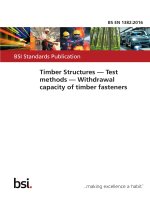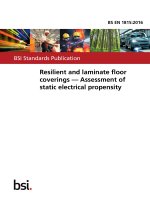Bsi bs en 61703 2016
Bạn đang xem bản rút gọn của tài liệu. Xem và tải ngay bản đầy đủ của tài liệu tại đây (4.87 MB, 104 trang )
BS EN 61703:2016
BSI Standards Publication
Mathematical expressions
for reliability, availability,
maintainability and
maintenance support terms
BRITISH STANDARD
BS EN 61703:2016
National foreword
This British Standard is the UK implementation of EN 61703:2016. It is
identical to IEC 61703:2016. It supersedes BS EN 61703:2002, which will be
withdrawn on 16 September 2019.
The UK participation in its preparation was entrusted to Technical
Committee DS/1, Dependability.
A list of organizations represented on this committee can be obtained on
request to its secretary.
This publication does not purport to include all the necessary provisions of
a contract. Users are responsible for its correct application.
© The British Standards Institution 2016.
Published by BSI Standards Limited 2016
ISBN 978 0 580 82730 3
ICS 03.120.30; 21.020
Compliance with a British Standard cannot confer immunity from
legal obligations.
This British Standard was published under the authority of the
Standards Policy and Strategy Committee on 31 December 2016.
Amendments/corrigenda issued since publication
Date
Text affected
BS EN 61703:2016
EUROPEAN STANDARD
EN 61703
NORME EUROPÉENNE
EUROPÄISCHE NORM
November 2016
ICS 03.120.30; 21.020
Supersedes EN 61703:2002
English Version
Mathematical expressions for reliability, availability,
maintainability and maintenance support terms
(IEC 61703:2016)
Expressions mathématiques pour les termes de fiabilité, de
disponibilité, de maintenabilité et de logistique de
maintenance
(IEC 61703:2016)
Mathematische Ausdrücke für Begriffe der Zuverlässigkeit,
Verfügbarkeit, Instandhaltbarkeit und
Instandhaltungsbereitschaft
(IEC 61703:2016)
This European Standard was approved by CENELEC on 2016-09-16. CENELEC members are bound to comply with the CEN/CENELEC
Internal Regulations which stipulate the conditions for giving this European Standard the status of a national standard without any alteration.
Up-to-date lists and bibliographical references concerning such national standards may be obtained on application to the CEN-CENELEC
Management Centre or to any CENELEC member.
This European Standard exists in three official versions (English, French, German). A version in any other language made by translation
under the responsibility of a CENELEC member into its own language and notified to the CEN-CENELEC Management Centre has the
same status as the official versions.
CENELEC members are the national electrotechnical committees of Austria, Belgium, Bulgaria, Croatia, Cyprus, the Czech Republic,
Denmark, Estonia, Finland, Former Yugoslav Republic of Macedonia, France, Germany, Greece, Hungary, Iceland, Ireland, Italy, Latvia,
Lithuania, Luxembourg, Malta, the Netherlands, Norway, Poland, Portugal, Romania, Slovakia, Slovenia, Spain, Sweden, Switzerland,
Turkey and the United Kingdom.
European Committee for Electrotechnical Standardization
Comité Européen de Normalisation Electrotechnique
Europäisches Komitee für Elektrotechnische Normung
CEN-CENELEC Management Centre: Avenue Marnix 17, B-1000 Brussels
© 2016 CENELEC All rights of exploitation in any form and by any means reserved worldwide for CENELEC Members.
Ref. No. EN 61703:2016 E
BS EN 61703:2016
EN 61703:2016
European foreword
The text of document 56/1682/FDIS, future edition 2 of IEC 61703, prepared by IEC/TC 56
"Dependability" was submitted to the IEC-CENELEC parallel vote and approved by CENELEC as
EN 61703:2016.
The following dates are fixed:
•
latest date by which the document has to be
implemented at national level by
publication of an identical national
standard or by endorsement
(dop)
2017-06-16
•
latest date by which the national
standards conflicting with the
document have to be withdrawn
(dow)
2019-09-16
This document supersedes EN 61703:2002.
Attention is drawn to the possibility that some of the elements of this document may be the subject of
patent rights. CENELEC [and/or CEN] shall not be held responsible for identifying any or all such
patent rights.
Endorsement notice
The text of the International Standard IEC 61703:2016 was approved by CENELEC as a European
Standard without any modification.
In the official version, for Bibliography, the following notes have to be added for the standards indicated:
2
IEC 61508 Series
NOTE
Harmonized as EN 61508 Series.
IEC 61511 Series
NOTE
Harmonized as EN 61511 Series.
IEC 61025
NOTE
Harmonized as EN 61025.
IEC 61078
NOTE
Harmonized as EN 61078.
IEC 61165
NOTE
Harmonized as EN 61165.
BS EN 61703:2016
EN 61703:2016
Annex ZA
(normative)
Normative references to international publications
with their corresponding European publications
The following documents, in whole or in part, are normatively referenced in this document and are
indispensable for its application. For dated references, only the edition cited applies. For undated
references, the latest edition of the referenced document (including any amendments) applies.
NOTE 1 When an International Publication has been modified by common modifications, indicated by (mod), the relevant
EN/HD applies.
NOTE 2 Up-to-date information on the latest versions of the European Standards listed in this annex is available here:
www.cenelec.eu
Publication
Year
Title
EN/HD
Year
IEC 60050-192
2015
International electrotechnical vocabulary - Part 192: Dependability
-
ISO 3534-1
2006
Statistics - Vocabulary and symbols Part -1: General statistical terms and terms
used in probability
-
3
–2–
BS EN 61703:2016
IEC 61703:2016 © IEC 2016
CONTENTS
FOREWORD ......................................................................................................................... 6
INTRODUCTION ................................................................................................................... 8
1
Scope ............................................................................................................................ 9
2
Normative references................................................................................................... 10
3
Terms and definitions .................................................................................................. 10
4
Glossary of symbols and abbreviations ........................................................................ 13
4.1
General ............................................................................................................... 13
4.2
Acronyms used in this standard ........................................................................... 13
4.3
Symbols used in this standard ............................................................................. 15
5
General models and assumptions ................................................................................ 18
5.1
5.2
5.3
5.4
5.5
5.5.1
5.5.2
5.5.3
5.6
6
Constituents of up and down times ...................................................................... 18
Introduction to models and assumptions .............................................................. 19
State-transition approach .................................................................................... 20
Model and assumptions for non-repairable individual items .................................. 22
Assumptions and model for repairable individual items ......................................... 23
Assumption for repairable individual items .................................................... 23
Instantaneous repair .................................................................................... 24
Non-instantaneous repair ............................................................................. 25
Continuously operating items (COI) versus intermittently operating individual
items (IOI) ........................................................................................................... 26
Mathematical models and expressions ......................................................................... 27
6.1
Systems .............................................................................................................. 27
6.1.1
General ....................................................................................................... 27
6.1.2
Availability related expressions .................................................................... 29
6.1.3
Reliability related expressions ...................................................................... 36
6.1.4
Mean operating time between failures [192-05-13] and mean time
between failures ........................................................................................... 40
6.1.5
Instantaneous failure rate [192-05-06] and conditional failure intensity
(Vesely failure rate) ...................................................................................... 41
6.1.6
Failure density and unconditional failure intensity [192-05-08] ....................... 44
6.1.7
Comparison of λ (t), λ V (t), z(t) and f(t) for high and small MTTRs ................... 47
6.1.8
Restoration related expressions ................................................................... 47
6.2
Non-repairable individual items ............................................................................ 49
6.2.1
General ....................................................................................................... 49
6.2.2
Instantaneous availability [192-08-01] ........................................................... 50
6.2.3
Reliability [192-05-05] .................................................................................. 50
6.2.4
Instantaneous failure rate [192-05-06] .......................................................... 51
6.2.5
Mean failure rate [192-05-07] ....................................................................... 52
6.2.6
Mean operating time to failure [192-05-11] .................................................... 53
6.3
Repairable individual items with zero time to restoration ...................................... 54
6.3.1
General ....................................................................................................... 54
6.3.2
Reliability [192-05-05] .................................................................................. 54
6.3.3
Instantaneous failure intensity [192-05-08].................................................... 56
6.3.4
Asymptotic failure intensity [192-05-10] ........................................................ 58
6.3.5
Mean failure intensity [192-05-09] ................................................................. 59
6.3.6
Mean time between failures (see 3.3) ........................................................... 60
BS EN 61703:2016
IEC 61703:2016 © IEC 2016
–3–
6.3.7
6.3.8
6.3.9
Mean operating time to failure [192-05-11] .................................................... 60
Mean operating time between failures [192-05-13] ........................................ 61
Instantaneous availability [192-08-01], mean availability [192-08-05]
and asymptotic availability [192-08-07] ......................................................... 61
6.3.10
Mean up time [192-08-09] ............................................................................ 61
6.4
Repairable individual items with non-zero time to restoration ................................ 62
6.4.1
General ....................................................................................................... 62
6.4.2
Reliability [192-05-05] .................................................................................. 62
6.4.3
Instantaneous failure intensity [192-05-08].................................................... 64
6.4.4
Asymptotic failure intensity [192-05-10] ........................................................ 67
6.4.5
Mean failure intensity [192-05-09] ................................................................. 68
6.4.6
Mean operating time to failure [192-05-11] .................................................... 69
6.4.7
Mean time between failures (see 3.3) ........................................................... 70
6.4.8
Mean operating time between failures [192-05-13] ........................................ 71
6.4.9
Instantaneous availability [192-08-01] ........................................................... 71
6.4.10
Instantaneous unavailability [192-08-04] ....................................................... 73
6.4.11
Mean availability [192-08-05] ........................................................................ 74
6.4.12
Mean unavailability [192-08-06] .................................................................... 76
6.4.13
Asymptotic availability [192-08-07] ............................................................... 78
6.4.14
Asymptotic unavailability [192-08-08] ............................................................ 78
6.4.15
Mean up time [192-08-09] ............................................................................ 79
6.4.16
Mean down time [192-08-10] ........................................................................ 81
6.4.17
Maintainability [192-07-01] ........................................................................... 82
6.4.18
Instantaneous repair rate [192-07-20] ........................................................... 84
6.4.19
Mean repair time [192-07-21] ....................................................................... 86
6.4.20
Mean active corrective maintenance time [192-07-22] ................................... 87
6.4.21
Mean time to restoration [192-07-23] ............................................................ 88
6.4.22
Mean administrative delay [192-07-26] ......................................................... 89
6.4.23
Mean logistic delay [192-07-27] .................................................................... 90
Annex A (informative) Performance aspects and descriptors ............................................... 91
Annex B (informative) Summary of measures related to time to failure ................................ 92
Annex C (informative) Comparison of some dependability measures for continuously
operating items ................................................................................................................... 95
Bibliography ....................................................................................................................... 97
Figure 1 – Constituents of up time ....................................................................................... 18
Figure 2 – Constituents of down time................................................................................... 19
Figure 3 – Acronyms related to failure times ........................................................................ 19
Figure 4 – Simple state-transition diagram ........................................................................... 21
Figure 5 – Sample realization (chronogram) related to the system in Figure 4 ...................... 22
Figure 6 – State-transition diagram of a non-repairable individual item ................................. 22
Figure 7 – Sample realization of a non-repairable individual item ......................................... 23
Figure 8 – State-transition diagram of an instantaneously repairable individual item ............. 24
Figure 9 – Sample realization of a repairable individual item with zero time to
restoration .......................................................................................................................... 25
Figure 10 – State-transition diagram of a repairable individual item ...................................... 25
–4–
BS EN 61703:2016
IEC 61703:2016 © IEC 2016
Figure 11 – Sample realization of a repairable individual item with non-zero time to
restoration .......................................................................................................................... 26
Figure 12 – Comparison of an enabled time for a COI and an IOI ......................................... 26
Figure 13 – Equivalent operating time for IOI items .............................................................. 27
Figure 14 – State-transition graph for a simple redundant system ........................................ 27
Figure 15 – Markov graph for a simple redundant system .................................................... 28
Figure 16 – Evolution of the state probabilities related to the Markov model in Figure 15 ........ 28
Figure 17 – Evolution of A(t) and U(t) related to the Markov model in Figure 15 .................... 29
Figure 18 – Evolution of the Ast i (0, t) related to the Markov model in Figure 15 .................... 31
Figure 19 – Instantaneous availability and mean availability of a periodically tested item ........ 33
Figure 20 – Example of a simple production system ............................................................. 34
Figure 21 – Evolution of A(t) and K(t) .................................................................................. 35
Figure 22 – Illustration of a system reliable behaviour over [0, t] .......................................... 36
Figure 23 – Illustration of a system reliable behaviour over time interval [t 1 , t 2 ] .................... 37
Figure 24 – State-transition and Markov graphs for reliability calculations ............................ 37
Figure 25 – Evolution of the state probabilities related to the Markov model in Figure 24 ........ 38
Figure 26 – Evolution of R(t) and F(t) related to the Markov model in Figure 24 .................... 39
Figure 27 – Evolution of Ast i (0, t) related to the Markov model in Figure 24 .......................... 40
Figure 28 – Time between failures versus operating time between failures ........................... 40
Figure 29 – Comparison between λ (t) and λ V (t) related to the model in Figure 24 ................ 43
Figure 30 – Comparison between z(t) and f(t) ...................................................................... 46
Figure 31 – Comparison of λ (t), λ V (t), z(t) and f(t) for high and small values of MTTRs ......... 47
Figure 32 – Illustration of reliable behaviour over [t 1 , t 2 ] for a zero time to restoration
individual item .................................................................................................................... 55
Figure 33 – Sample of possible number of failures at the renewal time t ............................... 56
Figure 34 – Illustration of reliable behaviour over [t 1 , t 2 ] for a non-zero time to
restoration individual item ................................................................................................... 62
Figure 35 – Evolution of R(t, t + 1/4) .................................................................................... 64
Figure 36 – Sample of possible number of failures at the renewal time t ............................... 64
Figure 37 – Evolution of the failure intensity z(t) .................................................................. 66
Figure 38 – Evolution of the mean failure intensity z(t, t + 1/4) .............................................. 69
Figure 39 – Illustration of available behaviour at time t for a non-zero time to
restoration individual item ................................................................................................... 71
Figure 40 – Evolution of the instantaneous availability A(t) ................................................... 73
Figure 41 – Illustration of unavailable behaviour at time t for a non-zero time to
restoration individual item ................................................................................................... 73
Figure 42 – Evolution of the instantaneous unavailability U(t) ............................................... 74
Figure 43 – Evolution of the mean availability A (t, t + 1/ 4 ) .................................................... 76
Figure 44 – Evolution of the mean unavailability U (t, t + 1/ 4) ................................................ 77
Figure 45 – Sample realization of the individual item state ................................................... 80
Figure 46 – Plot of the up-time hazard rate function λU (t ) .................................................... 80
Figure 47 – Evolution of the maintainability M(t, t+16h) ........................................................ 84
Figure 48 – Evolution of the lognormal repair rate µ (t) ......................................................... 86
BS EN 61703:2016
IEC 61703:2016 © IEC 2016
–5–
Figure A.1 – Performance aspects and descriptors .............................................................. 91
Table B.1 – Relations among measures related to time to failure of continuously
operating items ................................................................................................................... 92
Table B.2 – Summary of characteristics for some continuous probability distributions of
time to failure of continuously operating items .................................................................... 93
Table B.3 – Summary of characteristics for some probability distributions of repair time ....... 94
Table C.1 – Comparison of some dependability measures of continuously operating
items with constant failure rate λ and restoration rate µR .................................................... 95
–6–
BS EN 61703:2016
IEC 61703:2016 © IEC 2016
INTERNATIONAL ELECTROTECHNICAL COMMISSION
____________
MATHEMATICAL EXPRESSIONS FOR RELIABILITY,
AVAILABILITY, MAINTAINABILITY AND
MAINTENANCE SUPPORT TERMS
FOREWORD
1) The International Electrotechnical Commission (IEC) is a worldwide organization for standardization comprising
all national electrotechnical committees (IEC National Committees). The object of IEC is to promote
international co-operation on all questions concerning standardization in the electrical and electronic fields. To
this end and in addition to other activities, IEC publishes International Standards, Technical Specifications,
Technical Reports, Publicly Available Specifications (PAS) and Guides (hereafter referred to as “IEC
Publication(s)”). Their preparation is entrusted to technical committees; any IEC National Committee interested
in the subject dealt with may participate in this preparatory work. International, governmental and nongovernmental organizations liaising with the IEC also participate in this preparation. IEC collaborates closely
with the International Organization for Standardization (ISO) in accordance with conditions determined by
agreement between the two organizations.
2) The formal decisions or agreements of IEC on technical matters express, as nearly as possible, an international
consensus of opinion on the relevant subjects since each technical committee has representation from all
interested IEC National Committees.
3) IEC Publications have the form of recommendations for international use and are accepted by IEC National
Committees in that sense. While all reasonable efforts are made to ensure that the technical content of IEC
Publications is accurate, IEC cannot be held responsible for the way in which they are used or for any
misinterpretation by any end user.
4) In order to promote international uniformity, IEC National Committees undertake to apply IEC Publications
transparently to the maximum extent possible in their national and regional publications. Any divergence
between any IEC Publication and the corresponding national or regional publication shall be clearly indicated in
the latter.
5) IEC itself does not provide any attestation of conformity. Independent certification bodies provide conformity
assessment services and, in some areas, access to IEC marks of conformity. IEC is not responsible for any
services carried out by independent certification bodies.
6) All users should ensure that they have the latest edition of this publication.
7) No liability shall attach to IEC or its directors, employees, servants or agents including individual experts and
members of its technical committees and IEC National Committees for any personal injury, property damage or
other damage of any nature whatsoever, whether direct or indirect, or for costs (including legal fees) and
expenses arising out of the publication, use of, or reliance upon, this IEC Publication or any other IEC
Publications.
8) Attention is drawn to the Normative references cited in this publication. Use of the referenced publications is
indispensable for the correct application of this publication.
9) Attention is drawn to the possibility that some of the elements of this IEC Publication may be the subject of
patent rights. IEC shall not be held responsible for identifying any or all such patent rights.
International Standard IEC 61703 has been prepared by IEC technical committee 56:
Dependability.
This second edition cancels and replaces the first edition published in 2001. This edition
constitutes a technical revision.
This edition includes the following significant technical changes with respect to the previous
edition:
a) standard made as self containing as possible;
b) item split between individual items and systems;
c) generalization of the dependability concepts for systems made of several components;
–
introduction of the conditional failure intensity (Vesely failure rate);
–
introduction of the state-transition and the Markovian models;
BS EN 61703:2016
IEC 61703:2016 © IEC 2016
–
–7–
generalization of the availability to production availability;
d) introduction of curves to illustrate the various concepts.
The text of this standard is based on the following documents:
FDIS
Report on voting
56/1682/FDIS
56/1693/RVD
Full information on the voting for the approval of this standard can be found in the report on
voting indicated in the above table.
This publication has been drafted in accordance with the ISO/IEC Directives, Part 2.
This International Standard is to be used in conjunction with IEC 60050-192:2015.
The committee has decided that the contents of this publication will remain unchanged until
the stability date indicated on the IEC website under "" in the data
related to the specific publication. At this date, the publication will be
•
reconfirmed,
•
withdrawn,
•
replaced by a revised edition, or
•
amended.
–8–
BS EN 61703:2016
IEC 61703:2016 © IEC 2016
INTRODUCTION
IEC 60050-192 provides definitions for dependability and its influencing factors, reliability,
availability, maintainability and maintenance support, together with definitions of other related
terms commonly used in this field. Some of these terms are measures of specific
dependability characteristics, which can be expressed mathematically.
It is important for the users to understand the mathematical meaning of those expressions and
how they are established. This is the purpose of the present International Standard which,
used in conjunction with IEC 60050-192, provides practical guidance essential for the
quantification of those measures. For those requiring further information, for example on
detailed statistical methods, reference should be made to the IEC 60605 series [23] 1.
Annex A provides a diagrammatic explanation of the relationships between some basic
dependability terms, related random variables, probabilistic descriptors and modifiers.
Annex B provides a summary of measures related to time to failure.
Annex C compares some dependability measures for continuously operating items.
The bibliography gives references for the mathematical basis of this standard, in particular,
the mathematical material is based on references [2], [6], [8], [9], [13], [14] and [18]; the
renewal theory (renewal and alternating renewal processes) can be found in [6], [8], [9], [10],
[11], [13], [15], and [17]; and more advanced treatment of renewal theory can be found in
references [1], [3], [12], [16], [19] and [20]. More information on the theory and applications of
Markov processes can be found in references [3], [9], [10], [15], [16], [17] and [19].
____________
1
Numbers in brackets refer to the Bibliography.
BS EN 61703:2016
IEC 61703:2016 © IEC 2016
–9–
MATHEMATICAL EXPRESSIONS FOR RELIABILITY,
AVAILABILITY, MAINTAINABILITY AND
MAINTENANCE SUPPORT TERMS
1
Scope
This International Standard provides mathematical expressions for selected reliability,
availability,
maintainability
and
maintenance
support
measures
defined
in
IEC 60050192:2015. In addition, it introduces some terms not covered in IEC 60050192:2015. They are related to aspects of the system of item classes (see hereafter).
According to IEC 60050-192:2015, dependability [192-01-22] is the ability of an item to
perform as and when required and an item [192-01-01] can be an individual part, component,
device, functional unit, equipment, subsystem, or system.
To account for mathematical constraints, this standard splits the items between the individual
items considered as a whole (e.g. individual components) and the systems made of several
individual items. It provides general considerations for the mathematical expressions for
systems as well as individual items but the individual items which are easier to model are
analysed in more detail with regards to their repair aspects.
The following item classes are considered separately:
•
Systems;
•
Individual items:
–
non-repairable [192-01-12];
–
repairable [192-01-11]:
i)
with zero (or negligible) time to restoration;
ii) with non-zero time to restoration.
In order to explain the dependability concepts which can be difficult to understand, keep the
standard self-contained and the mathematical formulae as simple as possible, the following
basic mathematical models are used in this standard to quantify dependability measures:
•
•
Systems:
–
state-transition models;
–
Markovian models.
Individual items:
–
random variable (time to failure) for non-repairable items;
–
simple (ordinary) renewal process for repairable items with zero time to restoration;
–
simple (ordinary) alternating renewal process for repairable items with non-zero time to
restoration.
The application of each dependability measure is illustrated by means of simple examples.
This standard is mainly applicable to hardware dependability, but many terms and their
definitions may be applied to items containing software.
– 10 –
2
BS EN 61703:2016
IEC 61703:2016 © IEC 2016
Normative references
The following documents, in whole or in part, are normatively referenced in this document and
are indispensable for its application. For dated references, only the edition cited applies. For
undated references, the latest edition of the referenced document (including any
amendments) applies.
IEC 60050-192:2015, International electrotechnical vocabulary – Part 192: Dependability
(available at )
ISO 3534-1:2006, Statistics – Vocabulary and symbols – Part 1: General statistical terms and
terms used in probability
3
Terms and definitions
For the purposes of this document, the terms and definitions given in IEC 60050-192:2015,
ISO 3534-1 and the following apply.
NOTE To facilitate the location of the full definition, the IEC 60050-192 reference for each term is shown [in
square brackets] immediately following each term, for example:
mean time to restoration [192-07-23]
The terms and definitions given in Clause 3, which do not appear in IEC 60050-192, are used in order to facilitate
the presentation of mathematical expressions of some IEC 60050-192 terms. Some terms have been taken from
IEC 60050-192 and modified for the needs of this standard.
3.1
instantaneous restoration intensity
restoration intensity
restoration frequency
ν (t)
limit, if it exists, of the quotient of the mean number of restorations [192-06-23] of a repairable
item [192-01-11] within time interval [t, t + ∆t], and ∆t, when ∆t tends to zero, given that the
item is as good as new at t = 0
v(t ) = lim
Δt →0 +
E [NR (t + Δt ) − NR (t ) | as good as new at t = 0]
Δt
where
N R (t) is the number of restorations in the time interval [0, t];
E
denotes the expectation.
Note 1 to entry: The difference between the restoration intensity and the repair rate comes from the conditions:
the item is as good as new at time t = 0 for the restoration intensity and for the repair rate the repair starts at time
t = 0. From a mathematical point of view, the restoration intensity is similar to the unconditional failure intensity
(see 3.8).
Note 2 to entry:
The unit of measurement of instantaneous restoration intensity is the unit of time to the power-1.
3.2
instantaneous repair rate
repair rate
µ (t)
limit, if it exists, of the quotient of the conditional probability that the repair is completed within
time interval [t, t + ∆t] and ∆t, when ∆t tends to zero, given that the repair started at t = 0 and
had not been completed before time t
BS EN 61703:2016
IEC 61703:2016 © IEC 2016
– 11 –
Note 1 to entry: The difference between the restoration intensity and the repair rate comes from the conditions:
the item is as good as new at time t = 0 for the restoration intensity and for the repair rate the repair starts at time
t = 0. From a mathematical point of view, the repair rate is similar to the failure rate (see 3.6).
[SOURCE: IEC 60050-192:2015, 192-07-20, modified — Note 1 to entry has been replaced
and Note 2 to entry deleted]
3.3
mean time between failures
METBF
expectation of the time which elapses between successive failures
Note 1 to entry: The concept of mean time between failures has been omitted from IEC 60050-192. It was defined
in IEC 60050-191 as “the expectation of time between failures”. The definition has been modified to explain the
acronym METBF (mean elapsed time between failures) which is used in this standard to avoid any confusion
between the mean time between failure (METBF) and the mean operating time between failures (MTBF or MOTBF).
[SOURCE: IEC 60050-191:1990, 191-12-08, modified — acronym and Note 1 to entry added]
3.4
up-time distribution function
function giving, for every value of t, the probability that an up-time will be less than, or equal
to, t
Note 1 to entry:
If the up-time is (strictly) positive and a continuous random variable, then F U (0) = 0 and
FU (t ) = 1 − exp −
t
∫0 λU ( x) dx
where
λ U (t)
is the instantaneous up-time hazard rate function.
Note 2 to entry: The up-time distribution function is the general up-time distribution valid for both COI
(continuously operating item) and IOI (intermittently operating item). For COIs, F U (t) = F(t)
Note 3 to entry:
If the up time is exponentially distributed, then
F U (t) = 1 − exp(−t/MUT)
where MUT is the mean up-time.
In this case, the reciprocal of MUT is denoted by λ U and λ U = 1/MUT
3.5
instantaneous up-time hazard rate function
up-time hazard rate function
λ U (t)
limit, if it exists, of the quotient of the conditional probability that the up-time will end within
time interval [t, t + ∆t] and ∆t, when ∆t tends to zero, given that the up-time started at t = 0
and had not been finished before time t
Note 1 to entry:
The instantaneous up-time hazard rate function is expressed by the formula:
lU (t ) = lim
Δt → 0 +
f U (t )
1 FU (t + Δt ) − FU (t )
=
Δt
1 − FU (t )
1 − FU (t )
where F U (t) is the up-time distribution function and f U (t) is the probability density function of the up-time.
Note 2 to entry:
(see 3.6).
λ U (t) is the general hazard rate for the up times valid for both COI and IOI. For COIs, λ U (t) = λ (t)
Note 3 to entry: If the up time is exponentially distributed, then the instantaneous up-time hazard rate function is
constant in time and is denoted by λ U .
– 12 –
Note 4 to entry:
power −1.
BS EN 61703:2016
IEC 61703:2016 © IEC 2016
The unit of measurement of instantaneous up-time hazard rate function is the unit of time to the
3.6
instantaneous failure rate
failure rate
λ (t)
limit, if it exists, of the quotient of the conditional probability that the failure of an item occurs
within time interval [t, t + ∆t], by ∆t, when ∆t tends to zero, given that failure has not occurred
within time interval [0, t]
Note 1 to entry:
The instantaneous failure rate is expressed by the formula:
l (t ) = lim
Δt → 0 +
f (t )
1 F (t + Δt ) − F (t )
=
R(t )
R(t )
Δt
where F(t) and f(t) are, respectively, the distribution function and the probability density at the failure instant, and
where R(t) is the reliability function, related to the reliability R(t 1 , t 2 ) by R(t) = R(0, t).
Note 2 to entry: The restriction to non-repairable items in the definition provided by IEC 60050-192 can be
removed to generalize this definition for any kind of items i.e. systems or individual items, repairable or not.
Note 3 to entry:
3.5).
The instantaneous failure rate is the up-time hazard rate for COIs. In this case, λ (t) = λ U (t) (see
Note 4 to entry: When ∆t →0+, the failure rate is the conditional probability per unit of time that the item fails
between t and t + ∆t, given it is in up state all over the time interval [0, t]. It is usually assumed that the item is as
good as new at time 0.
Note 5 to entry:
The instantaneous failure rate may be also expressed by the formula:
l (t ) = lim
Δt → 0 +
E [N (t + Δt ) − N (t ) | up state over [0, t]]
Δt
where N(t) is the number of failures in the time interval [0, t], where E denotes the expectation.
This form of the definitions allows comparisons of the failure rate to the conditional failure intensity and to the
unconditional failure intensity.
[SOURCE: IEC 60050-192:2015, 192-05-06, modified — generalized to systems with
repairable components and Notes to entry added]
3.7
conditional failure intensity
Vesely failure rate
λ v (t)
limit, if it exists, of the quotient of the mean number of failures of a repairable item within time
interval [t, t + ∆t], by ∆t, when ∆t tends to zero, given that the item is in up state at time t and
as good as new at time 0
Note 1 to entry:
The instantaneous failure intensity is expressed by the formula:
l V (t ) = lim
Δt → 0 +
E [N (t + Δt ) − N (t ) | up state at t and as good as new at time 0]
Δt
where N(t) is the number of failures in the time interval [0, t], where E denotes the expectation.
Note 2 to entry: When ∆t →0+, the conditional failure intensity is the probability per unit of time that the item fails
between t and t + dt, given it is in up state at time t and as good as new at time 0. In particular cases (quick
restoration of failures), it provides good approximations of the failure rate. This parameter introduced in 1970 by W.
E. Vesely [26] is also called Vesely failure rate.
Note 3 to entry: According to the definitions, λ V (t) and z(t) are linked by the formula: λ V (t) = z(t)/ Α (t). where Α (t)
is the item instantaneous availability at time t.
BS EN 61703:2016
IEC 61703:2016 © IEC 2016
– 13 –
3.8
unconditional failure intensity
instantaneous failure intensity
failure intensity
failure frequency
z(t)
limit, if it exists, of the quotient of the mean number of failures of a repairable item within time
interval [t, t + ∆t], by ∆t, when ∆t tends to zero, given that the item is as good as new at time
t= 0
Note 1 to entry:
The instantaneous failure intensity is expressed by the formula:
z(t ) = lim
Δt → 0 +
E [N (t + Δt ) − N (t ) | as good as new at t = 0]
Δt
where N(t) is the number of failures in the time interval [0, t], where E denotes the expectation and where the
implicit condition that the item is as good as new at time t = 0 has been added.
Note 2 to entry: The unconditional failure intensity is the failure intensity as defined in IEC 60050-192:2015 [19205-08]. It is also sometimes named ROCOF (rate of occurrence of failure).
Note 3 to entry: When ∆t →0+, the unconditional failure intensity is the probability per unit of time that the item
fails between t and t + dt given that the item is in up state at time t = 0. Here the item may be in any state at time t
and this is why the adjective unconditional is used.
Note 4 to entry: According to the definitions, λ V (t) and z(t) are linked by the formula: z(t) = Α (t). λ V (t) where Α (t) is
the item instantaneous availability at time t.
[SOURCE: IEC 60050-192:2015, 192-05-08, modified — synonyms have been added and the
entry has been revised]
3.9
continuously operating item
COI
item for which operating time [192-02-05] is equal to its enabled time [192-02-17]
3.10
intermittently operating item
IOI
item for which operating time [192-02-05] is less than its enabled time [192-02-17]
Note 1 to entry: In this case, the enabled time of the item is made of the sum of the times spent in the operating
[192-02-04], idle [192-02-14] and standby [192-02-10] states.
4
Glossary of symbols and abbreviations
4.1
General
The symbols and abbreviations given in Clause 4 are widely used and recommended,
however, they are not mandatory. For consistency of presentation, the notation in this
document may differ from that used in a referenced document.
4.2
Acronyms used in this standard
Acronym/abbreviation
Meaning
COI
Continuously operating item
IOI
Intermittently operating item
MACMT
Mean active corrective maintenance time, i.e. the expectation of
the active corrective maintenance time
BS EN 61703:2016
IEC 61703:2016 © IEC 2016
– 14 –
Acronym/abbreviation
∧
Meaning
MACMT
Point estimate of the mean active corrective maintenance time
MAD
Mean administrative delay
∧
MAD
Point estimate of the mean administrative delay
MADT(t 1 , t 2 )
Mean accumulated down time over the time interval [t 1 , t 2 ]
MADT(t1, t2 )
Point estimate of the mean accumulated down time over the time
interval [t 1 , t 2 ]
MAUT(t 1 , t 2 )
Mean accumulated up time over the time interval [t 1 , t 2 ]
∧
MAUT(t1, t 2 )
Point estimate of the mean accumulated up time over the time
interval [t 1 , t 2 ]
MDT
Mean down time
∧
∧
MDT
Point estimate of the mean down time
METBF
Mean (elapsed) time between failures
MFDT
Mean fault detection time, i.e. the expectation of the fault
detection time
MLD
Mean logistic delay
∧
MLD
Point estimate of the mean logistic delay
MMAT
Mean maintenance action time, i.e. the expectation of a given
maintenance action time
MRT
Mean repair time
∧
MRT
Point estimate of the mean repair time
MOTBF
Mean operating time between failures
MTD
Mean technical delay, i.e. the expectation of the technical delay
MTTF
Mean time to failure
∧
MTTF
Point estimate of the mean time to failure
MTTR
Mean time to restoration
∧
MTTR
Point estimate of the mean time to restoration
MUT
Mean up time
∧
MUT
Point estimate of the mean up time
RT i
Observed repair time of item i
TTF i
Time to failure of item i
VRT
The variance of repair time, VRT = Var[ ζ ] = E[ ζ 2 ] − MRT 2 , where
ζ is a random variable representing the repair time, Var denotes
the variance and E denotes the expectation
BS EN 61703:2016
IEC 61703:2016 © IEC 2016
4.3
– 15 –
Symbols used in this standard
Symbol
Meaning
[t 1 , t 2 ]
Interval where t 1 is the lower bound and t 2 the upper bound (t 1 < t 2 )
Ast i (t 1 , t 2 )
Mean accumulated sojourn time in state i over the interval [t 1 , t 2 ]
A
Asymptotic availability
A(t)
Instantaneous availability (availability function), i.e. the probability of
the item being in an up state at the instant of time t
A(t1, t2 )
Mean availability for the time interval [t 1 , t 2 ]
A
Asymptotic mean availability
ˆ
A(t1, t2 )
Point estimate of the mean availability for the time interval [t 1 , t 2 ]
∆t
Small strictly positive increment of time. ∆t > 0
dt
Infinitesimal strictly positive increment of time (i.e. ∆t which tends to
zero)
E[.]
Expectation
F U (t)
Up time distribution function
f U (t)
Probability density function of the up times
NOTE
f(t)
fˆ (t )
For COIs, f U (t) = f(t).
Probability density function of the (operating) times to failure
Point estimate at time t of the probability density function of the
(operating) time to failure
f R+U (t)
Probability density function of the sum of the time to restoration and
the following up time
G(t)
Distribution function of the repair times
G ACM (t)
Distribution function of the active corrective maintenance time
G R (t)
Distribution function of the times to restoration
g(t)
Probability density function of the repair times
gˆ (t )
Point estimate at time t of the probability density function of the
repair time
g ACM (t)
Probability density function of the active corrective maintenance
times
g AD (t)
Probability density function of the administrative delays
g D (t)
Probability density function of the down times
g LD (t)
Probability density function of the logistic delays
g MA (t)
Probability density function of the given maintenance action time
g R (t)
Probability density function of the times to restoration
(n)
hCTTF
(t )
Probability density function of calendar time to the nth failure, n ≥ 1
KA, KS , Ki
Nominal (production) capacity related to an item A, a system S or a
state i
K(t)
Instantaneous (production) capacity related to a system
k
Number of repair times during a given period of observation
BS EN 61703:2016
IEC 61703:2016 © IEC 2016
– 16 –
Symbol
Meaning
k ACM
Number of active corrective maintenance times during a given period
of observation
k AD
Number of administrative delays during a given period of observation
kD
Number of down times during a given period of observation
kF
Number of failures during a given period of observation
k LD
Number of logistic delays during a given period of observation
kO
Number of failures while operating during a given period of
observation
kR
Number of times to restoration during a given period of observation
kU
Number of up times during a given period of observation
λ
Constant failure rate, i.e. the reciprocal of mean time to failure
(MTTF) when time to failure is exponentially distributed
λ (t)
Instantaneous failure rate
λ(∞)
Asymptotic failure rate
λˆ
Point estimate of the constant failure rate
λˆ(t )
Point estimate of the instantaneous failure rate at time t
λ (t1, t2 )
Mean failure rate for the time interval [t 1 , t 2 ]
λU
Constant up-time hazard rate function, i.e. the reciprocal of the
mean up time (MUT) when up times are exponentially distributed
NOTE 1
λU (t )
For COIs, λ U = λ
The up-time hazard rate function
NOTE 2
For COIs, λ U (t) = λ (t)
λV (t )
Conditional failure intensity (Vesely failure rate)
λV(∞)
Asymptotic conditional failure intensity (Asymptotic Vesely failure
rate)
M(t)
Maintainability function, i.e. the probability of completing a given
maintenance action within time t: M(t) = M(t 1 , t 2 ) for t 1 = 0 and t 2 = t
Mˆ (t )
Point estimate at time t of the maintainability function
M(t 1 , t 2 )
Maintainability for the time interval [t 1 , t 2 ]
m
Number of observed maintenance action times
mMAT (t )
Number of maintenance action times with duration greater that t
( mMAT (0) = m )
µ
Constant repair rate, i.e. the reciprocal of the mean repair time
(MRT) when the repair times are exponentially distributed
µ (t)
Instantaneous repair rate
µˆ (t )
Point estimate at time t of the instantaneous repair rate
µ ACM
Reciprocal of the mean active corrective maintenance time (MACMT)
when the active corrective maintenance times are exponentially
distributed
BS EN 61703:2016
IEC 61703:2016 â IEC 2016
17
Symbol
Meaning
à AD
Reciprocal of the mean administrative delay (MAD) when the
administrative delays are exponentially distributed
µD
Reciprocal of the mean down time (MDT) when the down times are
exponentially distributed
µ LD
Reciprocal of the mean logistic delay (MLD) when the logistic delays
are exponentially distributed
µ MA
Constant rate of the completion of a given maintenance action, when
the maintenance action time is exponentially distributed
µR
Constant restoration rate, i.e. the reciprocal of the mean time to
restoration (MTTR) when the times to restoration are exponentially
distributed
N(t)
Number of failures occurring in the time interval [0, t]
N R (t)
Number of restorations occurring in the time interval [0, t]
n
Number of items in the population
n D {t}
Number of items that are in a down state at the instant of time t
n F (t, t + ∆t)
Number of failures observed during the time interval [t, t + ∆t], where
the time scale includes both up and down times
n F (t 1 , t 2 )
Number of failures observed during the time interval [t 1 , t 2 ], where
the time scale includes both up and down times
n R (t)
Number of repairable items that are still under repair at the instant of
time t (n R (0) = n)
n R (t + ∆t) − n R (t)
Number of items with repair completed in the time interval [t, t + ∆t]
n S (t)
Number of (non-repairable) items that are still operational at the
instant of time t (n S (0) = n)
n S (t 1 , t 2 )
Number of items that were operational at the instant of time t 1 and
operated without failure in the time interval [t 1 , t 2 ]
n S (t + ∆t) − n S (t)
Number of items that fail in the time interval [t, t + ∆t]
n U {t}
Number of items that are in an up state at the instant of time t
v(t)
Instantaneous restoration intensity
P(.)
Probability. The dot stands for any relevant event or random variable
P i (t), Pi( av ) (t ) , Pi( rel ) (t )
Probability of state i in state-transition models, probability of state i
for an "availability" Markov graph (see 6.1.2.1), probability of state i
for a "reliability" Markov graph (see 6.1.3.1)
Prod(t)
Instantaneous production at time t
Prod (t1, t 2 )
Mean production availability over the time interval [t 1 , t 2 ]
R(t)
Reliability function, i.e. the probability of survival until time t
R(t) = R(t 1 , t 2 ) for t 1 = 0 and t 2 = t
Rˆ (t )
Point estimate at time t of the reliability function
R(t 1 , t 2 )
Reliability for the time interval [t 1 , t 2 ]
Rˆ (t1, t2 )
Point estimate for the time interval [t 1 , t 2 ] of the reliability function
R ( t, t + x | t )
Conditional reliability for the time interval [t, t + x], assuming that the
item is in up state at time t
ρ
Production per unit of time
BS EN 61703:2016
IEC 61703:2016 © IEC 2016
– 18 –
Symbol
Meaning
t
Instant in time
T
Instant in time or duration depending on the context
Tbf (t )
Mean elapsed time between the consecutive failures occurring over
the time interval [0, t]
τ
Instant in time or tests interval depending on the context
U
Asymptotic unavailability
U(t)
Instantaneous unavailability (unavailability function)
U (t1, t 2 )
Mean unavailability for the time interval [t 1 , t 2 ]
U
Asymptotic mean unavailability
ˆ
U (t1, t2 )
Point estimate of the mean unavailability for the time interval [t 1 , t 2 ]
V(t 1 , t 2 )
Mean number of restorations over the time interval [t 1 , t 2 ]
Z(t)
Expected number of failures in the time interval [0, t] Z(t) = E[N(t)],
where E denotes the expectation
z(t)
Instantaneous failure intensity (failure frequency)
z(∞)
Asymptotic failure intensity
zˆ(t )
Point estimate of the instantaneous failure intensity at time t
z (t1, t2 )
Mean failure intensity for the time interval [t 1 , t 2 ]
ˆ
z (t1, t2 )
Point estimate of the mean failure intensity for the time interval [t 1 ,
t2]
5
5.1
General models and assumptions
Constituents of up and down times
In order to understand the mathematical expressions included in this standard, it is important
to understand what constitutes up time and down time. IEC 60050-192 splits the up time
(where the item performs as required) and down time (where the item does not perform as
required) into their constituents. This is summarized in Figure 1 and Figure 2 in
IEC 60050192:2015 which also provides definitions of mean values for some of those
constituents.
Figure 1 and Figure 2 (that have been adapted from IEC 60050-192) respectively summarize
the constituents of up time and down time which are relevant to this standard. (Neither the
“preventive maintenance time” nor the “externally disabled” time have been considered). The
acronyms for the mean values included in this standard have been added in Figures 1 and 2.
Up time [192-02-02]
Enabled time [192-02-17]
Operating time
[192-02-05]
Non operating time [192-02-07]
Idle time [192-02-15]
Standby time [192-02-13]
MUT [192-08-09]
IEC
Figure 1 – Constituents of up time
BS EN 61703:2016
IEC 61703:2016 © IEC 2016
– 19 –
Down time [192-02-21]
Non-operating time [192-02-07]
Time to restoration [192-07-06]
Corrective maintenance time [192-07-07]
Active corrective maintenance time [192-07-10]
Logistic delay
[192-07-13] Technical delay
[192-07-15]
Repair time
[192-07-19]
Fault
localization time
[192-07-18]
Fault
correction time
[192-07-14]
MTD
MLD
[192-07-27]
Function
checkout time
[192-07-16]
Fault
detection time
[192-07-11]
Administrative
delay
[192-07-12]
MFDT
MAD
[192-07-26]
MRT [192-07-21]
MACMT [192-07-22]
MTTR [192-07-23]
MDT [192-08-10]
IEC
Figure 2 – Constituents of down time
IEC 60050-192 defines several acronyms for mean time related to the item failures occurring
during the operating state. This is summarized in Figure 3.
Non-repairable item
[192-01-12]
Operating time
to 1st failure
[192-05-02]
Operating time
to failure
[192-05-01]
MTTFF
[192-05-12]
MTTF
[192-05-11]
Operating time
(Elapsed) time
between failures between failures
[192-05-04]
[192-05-03]
MOTBF / MTBF
[192-05-13]
METBF
Repairable item [192-01-11]
IEC
Figure 3 – Acronyms related to failure times
NOTE In text books on the subject of reliability, the acronym MTBF is often used for the mean time between
failures. According to IEC 60050-192, this acronym is used for the mean "operating" time between failures.
Therefore to avoid any confusion, the acronym METBF (see 3.3) is used in this standard for the mean time
between failures.
5.2
Introduction to models and assumptions
In order to derive correct mathematical expressions for selected dependability measures
defined in IEC 60050192, distinction is made between items considered as a whole
(individual items) and items made of several individual items (systems). The following classes
of items are considered separately in this standard:
•
Systems;
•
Individual items:
–
non-repairable items [192-01-12];
–
repairable items [192-01-11]:
i)
with zero time to restoration;
ii) with non-zero time to restoration.
NOTE 1
The term "item" is used in this standard when it applies to systems and individual items.
– 20 –
BS EN 61703:2016
IEC 61703:2016 © IEC 2016
NOTE 2 The term "non-repairable" item encompasses items which are either not repairable or are repairable but
are not repaired when failed. The term "repairable" item encompasses only those items which are repairable and
actually repaired when failed.
In order to keep the standard self-contained and the mathematical formulae as simple as
possible, the following basic mathematical models are used to quantify dependability
measures:
–
state-transition models for systems;
–
renewal processes for individual items.
The general way to model an item is to identify its various states and to analyse how it goes
from state to state when the time is elapsing: this can be done by using state-transition
models. Such models are useful in illustrating the development of the mathematical
expressions for various dependability measures. When no particular assumptions are made
regarding the probabilistic distributions, these models can be handled only in particular and
simple cases using analytical calculations. Otherwise Monte Carlo simulation needs to be
used. This is why, for systems, as well as individual items, the hypothesis of constant
transition rates, is often made in order to use Markovian models which are well known and for
which powerful analytical algorithms are available.
For individual items, under the assumption that they have only two states, the general
formulae with non-constant transition rates can be derived to some extent. This is shown in
6.2, 6.3 and 6.4:
–
non-repairable individual items: this is the simplest mathematical model as only one
random variable applies: the time to failure of the item [192-05-01]. It can be characterized
by its reliability R(t), its instantaneous failure rate, λ (t) [192-05-06], also referred to as
the hazard rate associated with the time to failure distribution (i.e. the unreliability
function) or its mean time to failure MTTF [192-05-11] which is also its mean time to first
failure MTTFF [192-05-12].
–
repairable individual items: the basic model is a simple (ordinary) renewal process, when
the time to restoration of the item may be neglected, or a simple (ordinary) alternating
renewal process in which the time to restoration of the item is non-zero. In the latter case,
the item alternates between an up state and a down state, and, in addition to the common
dependability measures, a widely used measure of reliability of the item is the failure
intensity [192-05-08], which, in this case, is equal to the renewal density.
To avoid improper use of these mathematical expressions, which could yield erroneous
results, the specific assumptions detailed in 5.4 and 5.5 should be observed.
In order to allow for easy comprehension, some definitions have been repeated in different
parts of this standard, as needed.
5.3
State-transition approach
A simple way to introduce the dependability concepts is to analyse the behaviour of an item
(i.e. an individual item or a system) during its evolution between up and down states.
This can be done by using a state-transition graph such as the one presented in the right
hand side of Figure 4. It is related to the system represented by the reliability block diagram
(see IEC 61078 [25]) on the left hand side of the figure. This system is made of three similar
blocks (A i ) organized in a two out of three architecture and of one block B in standby position
which immediately takes over the function of the first of the blocks A i going to its down state.
The switching between A i and B is considered to be perfect (i.e. instantaneous and without
failure).
BS EN 61703:2016
IEC 61703:2016 © IEC 2016
– 21 –
IEC
Figure 4 – Simple state-transition diagram
As the blocks (A i ) are similar, the similar states can be aggregated to obtain the statetransition diagram presented in the right hand side of Figure 4. It comprises seven states
represented by circles and sixteen transitions represented by arrows. For example, the state 3
aggregates three similar states (A 1 and B in up states and other blocks in down states, A 2 and
B in up states and other blocks in down states, A 3 and B in up states and other blocks in
down states) and the line with arrows on each end between states 2 and 3 means that the
system can have transitions from 2 to 3 and from 3 to 2.
This state-transition diagram is sufficient to identify the classes of states which are essential
to define and understand the key dependability measures (e.g. availability, reliability, failure
rate, failure intensities, failure density).
The states can be grouped into two main classes which can furthermore be subdivided in two
sub classes:
•
•
system up state class: states 1, 2, 3 and 4 (where at least 2 of the blocks are in up
states). It is subdivided into:
–
non critical up state class: states 1 and 2 which are separated from the down state
class by more than one transition;
–
critical up states class: states 3 and 4 which are separated from the down state class
by only one transition;
system down state class: 5, 6 and 7 (where less than 2 of the blocks are in up states). It is
subdivided into:
–
non critical down state class: state 7 which is separated from the up state class by
more than one transition;
–
critical down state class: states 5 and 6 which are separated from the up state class by
only one transition.









